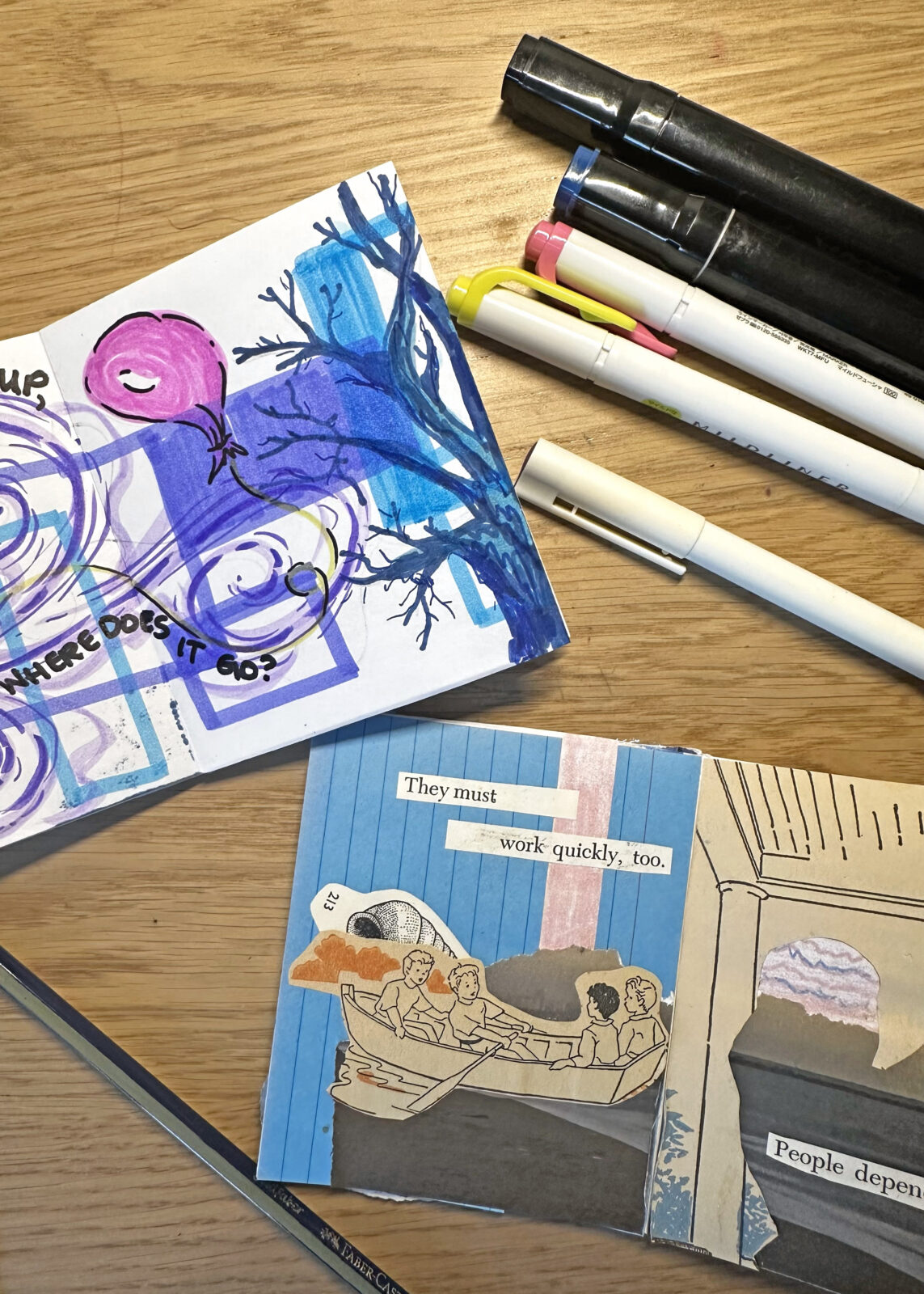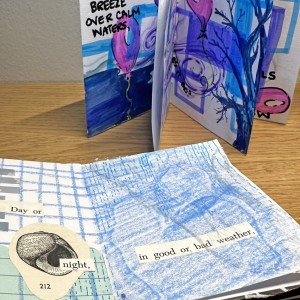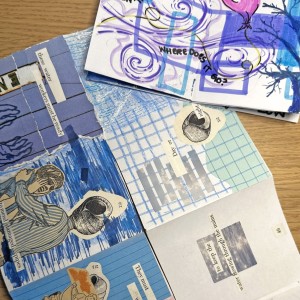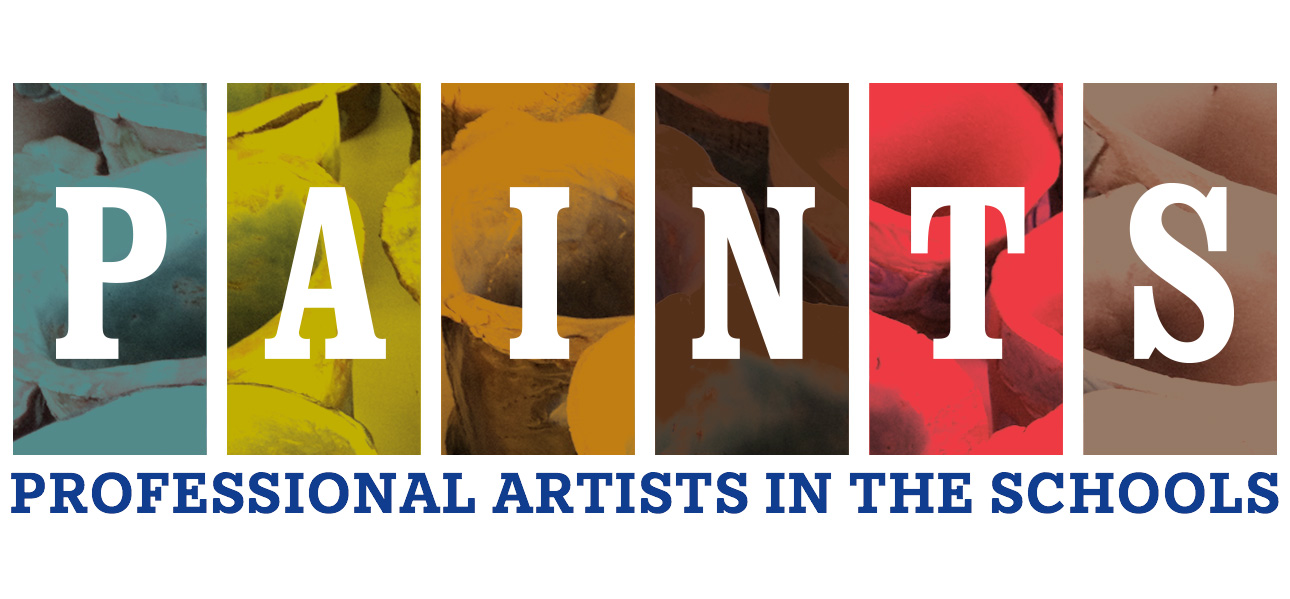
Mini-zines are all about experimentation and idea generation. Thread together similar images, sounds, words, or colours to contain a single idea, thought or narrative. By only cutting into the page once, we can fold together a small eight page booklet — six internal pages and two cover pages — that are a blank space to create.
The first half of the workshop we build a zines together on chart paper. We start with an idea generation exercise: how do artists connect ideas? Where can inspiration take us? I give the students a word then ask each to say one by one the first thing that pops into their heads about that word, repeats are okay. For example, I’ll say BLUE and get: sky, ocean, sadness, popsicle. I use these answers to generate a word list. Then we repeat with a pattern as a starting point, then an image as a starting point. This exercise gets the creative juices flowing and reminds the students that no thought is unimportant.
The class is then split into 2-4 groups (depending on size, I am also happy to accept pre-approved groups from teachers) and provided a piece of chart paper folded into the zine format. Students work together to create a zine using the ideas from the generated word list, or each create on their own page. We finish the first half by sharing and seeing the similarities and differences between them.
Once we’re ready to create individually, I start with a folding tutorial on how to make the booklet from a piece of legal paper. Students will then have two pathways to consider as they start building their zines. 1. Start with Imagery or 2. Start with Text.
Starting with Imagery sends those students to the materials provided: coloured paper, fun patterns/textiles, collaging elements (old magazine photos, clippings). Students are encouraged to find what inspires them, what interests them, and begin to sort similarities to compile a single idea for their zine.
Starting with Text is for students who may have an idea brewing already, are poetry inclined, or are drawn to planning ahead. They will be provided text samples from old books, magazines, prominent texts (with citations) to structure a narrative for their zine. They can also write text themselves!
I typically call for 30-45 minute switches where students can consider switching pathways, taking with them what they’re interested in using for their zine, and experimenting with the opposite material. Once they’ve collected everything they need from both stations, they can begin to compile/create/write their zine.
At breaks in the school day or if the workshop is completed over several days, I re-centre the students with tutorials for cohesive zine building: a) how to create colourful abstract backgrounds across all pages b) how to structure a narrative zine c) how to make one image three separate elements d) reviewing zine examples; before sending them back to continue individual work.
Being able to draw is NOT a necessity for zine creation and there are no drawing tutorials. I encourage students to rely on skills they already know and trust in their own creative processes. When provided collage imagery even the more non-artistically inclined students have a solid foundation to play/experiment without requiring drawing skills.
I end workshops with avenues for students to submit their zines professionally.
NOTE:
For grades 4 – 6 , I focus on collage and text elements from resources.
For grades 10-12: I can limit the group exercises to allow for more individual time.
About the artist - Kiera Sitzer
Kiera Sitzer is an artist, writer and baker in Dartmouth, Nova Scotia. She finished her BFA from Queen’s University in 2019 and struggled to remain connected to her art practice since then. She finds strength and value in community building by working with art organizations like Wonder’neath Art Society and Chester Art Centre. Kiera first connected with VANS through their New Grad Program in 2021. Her paintings have been exhibited by the Federation of Canadian Artists and Nuit Rose Festival of Queer Art. Becoming flexible with her process and materials has brought joy back to her artmaking – a joy she endeavours to share and advocate for within her community.
Learn more


